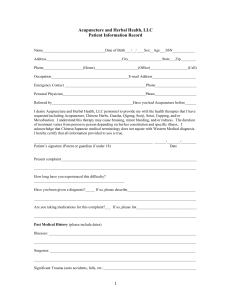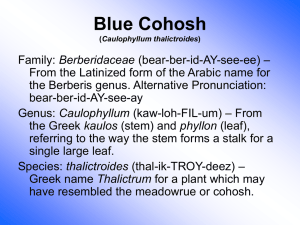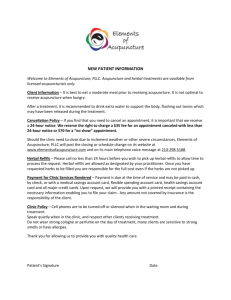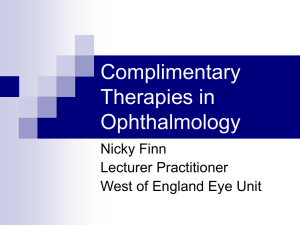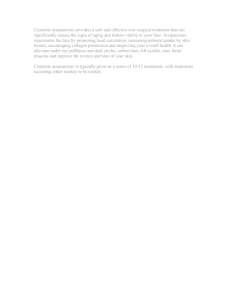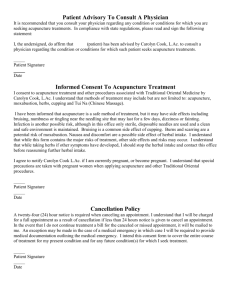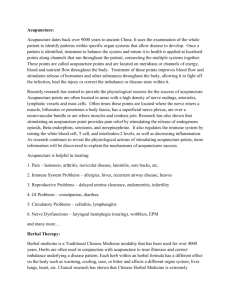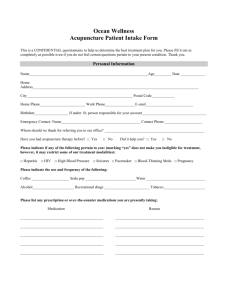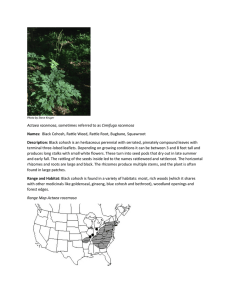Complementary and Alternative Medicine (CAM) Therapies in OB/GYN
advertisement
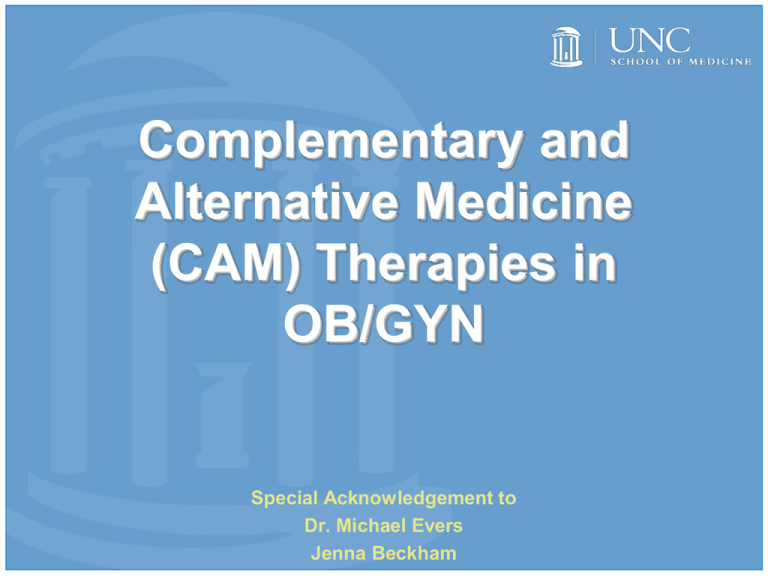
Complementary and Alternative Medicine (CAM) Therapies in OB/GYN Special Acknowledgement to Dr. Michael Evers Jenna Beckham Goals of this Lecture • Describe some common non-traditional medical therapies used for obstetrical and gynecological conditions • Discuss what current evidence says about these therapies • Identify potential benefits and harms associated with commonly used herbal supplements • To encourage you to include questions about nontraditional therapies when taking a history from a new patient Why should you care? • The 2007 National Health Interview Survey (NHIS), showed that approximately 38% of adults use CAM • Women tend to use CAM more than men • The use of herbal medicines has increased from 12.1% to 18.6% (1997 to 2002) • According to a 2007 government survey, Americans spent $33.9 billion out-of-pocket on CAM during the previous year • Potential benefits and potential interactions with traditional medicines Altern Ther Helath Med,11(1), Jan/Feb 2005, 42-49; JAMA, 280(18), Nov 11, 1998, 1569-1575 Nahin, RL, Barnes PM, Stussman BJ, and Bloom B. Costs of Complementary and Alternative Medicine (CAM) and Frequency of Visits to CAM Practitioners: United States, 2007. National health statistics reports; no 18. Hyattsville, MD: National Center for Health Statistics. 2009. The National Center for Complementary and Alternative Medicine http://nccam.nih.gov/ What Does ACOG have to say? Committee Opinion #227 (November 1997) acknowledges seven categories of Complementary and Alternative Medicine (CAM): 1. Mind-body interventions--yoga, meditation, t’ai chi, support groups and biofeedback 2. Alternative systems of medical practice--Traditional Chinese Medicine (TCM), homeopathy, chiropractic, acupuncture and Native-American medicine 3. Pharmacologic and biologic treatments--folk medicine, medicinal plants 4. Herbal medicine--the use of botanicals with pharmacologic activity 5. Diet and Nutrition--the use of nutritional supplements or vitamins as well as the use of specific diets to obtain health 6. Manual healing methods--massage, chiropractic manipulation and biofield therapeutics 7. Bioelectromagnetic applications--magnets, nerve stimulation Definitions Diet supplement--product (other than tobacco) that is intended to supplement the diet containing one or more of the dietary ingredients listed here: vitamin, mineral, an herb or other botanical, an amino acid, a dietary supplement used by humans to supplement the diet by increasing the total dietary intake, or a concentrate, metabolite, constituent, extract or combination of any ingredient described above DSHEA--Dietary Supplement Health and Education Act, passed in October, 1994; allowed for labeling and selling of dietary supplements with little to no oversight by the FDA Clin Obstet Gynecol, 44(4), Dec. 2001, 780-788 Definitions Allopathy--A therapeutic system in which disease is treated by producing a second condition that is incompatible with or antagonistic to the first. Conventional medicine in the United States. Definitions Homeopathy--System of therapy developed by Samuel Hahnemann based on the “law of similia”, from the aphorism, simila similibus curantur (likes are cured by likes), which holds that a medicinal substance that can evoke certain symptoms in healthy individuals may be effective in the treatment of illnesses having symptoms closely resembling those produced by the substance Therapy mediated through the potentiation of substances which are prepared with serial dilutions, often to the point in which no molecules of the active substance is detectable Flourished during the 1800’s when patients often did better than those treated with blood letting, emetics and other treatments. Definitions Acupuncture: • 2,000 acupuncture points on the body • Connected via 12 main and 8 secondary pathways (Meridians) • Meridians connect energy, qi (“chee”), between the surface of the body and the internal organs • Qi regulates spiritual, emotional, mental and physical balance • Qi is influenced by the opposing forces of yin and yang • When yin and yang are balanced, they work with the natural flow of qi to keep the body healthy • The placement of needles in the acupuncture points helps to keep the flow of qi unblocked. Who uses CAM? “Why Patients Use Alternative Medicine: Results of a National Study,” JAMA, 1998; 279: 15481553 1500 random surveys were sent out, 69% response rate (1035) Three Theories: 1. Dissatisfaction with conventional treatment 2. Need for personal control over treatment options and decisions over health care decisions 3. Philosophical congruence with patient’s worldview, spiritual/religious philosophy or beliefs regarding health and illness Who uses CAM? More educated (50% with graduate degrees as opposed to 31% of those with high school diploma or less) Those with holistic philosophy of health (“The health of my body, mind, and spirit are related, and whoever cares for my health should take that into account”) Had a transforming experience (“I’ve had a transformational experience that causes me to view the world differently than before”) Being dissatisfied with conventional medicine not predictive Who uses CAM? Defined their health status as poorer than non-users of CAM Specific conditions such as anxiety, back problems, chronic pain or urinary tract problems were predictive of using CAM Only 4% of people relied solely on CAM for therapy Highest rates of use in groups aged 35-49 (42%) and 50-64 (44%) Acupuncture A part of Traditional Chinese Medicine (TCM) 36 States have state licensure for acupuncture 9-12 million visits to acupuncturists take place in the United States Acupuncture needles are regulated by the FDA as medical devices Clin Obstet Gynecol, 44(4), Dec. 2001, 801-813; Anat Record, 262, 2002, 257-265 Acupuncture • Each of 12 primary meridians associated with and named for a specific organ • Organs represent more than just the anatomic structures • Approximately 360 acupuncture points lie along meridians • Endorphins and cortisol are released with point stimulation Clin Obstet Gynecol, 44(4), Dec. 2001, 801-813; Anat Record, 262, 2002, 257-265 www.scienceandsociety.co.uk Acupuncture’s uses for OB/GYNs Nausea and Vomiting: Revolves around acupuncture or acupressure at site P6 (Neiguan point) Sea-Band (Sea Band International, Greensboro, N.C.) Acupuncture’s uses for OB/GYNs Nausea and Vomiting: Multiple smaller studies have shown decreased levels of nausea and vomiting in the first trimester pregnancy, chemotherapy, motion and in the postoperative period The most methodologically sound of these studies involved 161 women in three groups (treatment, control, placebo) for 8 days All three groups reported significant decrease in nausea and vomiting, but there was no difference among treatment vs. placebo Am J Obstet Gynecol, 174(2), Feb. 1996, 708-715; Obstetrics & Gynecology, 2001;97:184-188 Acupuncture’s uses for OB/GYNs Nausea and Vomiting: 187 women over 21 days with nerve stimulation at P6 with ReliefBand (Woodside Biomedical, Carlsbad, CA.) or sham device Self-reporting scores for N/V decreased significantly Study group gained more weight (2.9 lbs vs. 1.2, P=0.003) No significant change in medication use between groups Obstetrics & Gynecology, 2003;102:129-135 Acupuncture’s uses for OB/GYNs Induction of Labor: Study from Vienna took 45 women at 40 weeks and administered treatment every other day for up to 10 days. Study group had statistical significant cervical shortening and interval to delivery (5.0 vs. 7.9 days) Two studies in Norway had mixed conclusions on use of a single acupuncture treatment after confirmation of SROM At UNC we took 56 nulliparous women at 39+4 weeks or beyond and half received 3 daily treatments. Study group was more likely to labor spontaneously and less likely to need a C/S Rabl M, et. al., Wien Klin Wochenshr, 113, 2001, 942-946; J. Mat-Fetal & Neonatal Med Aug. 2006; 19(8), 465-70; Acta Obstetricia et Gynecologica, 85, 2006, 1348-1353, Acta Obstetricia et Gynecologica, 86, 2007, 1447-1452 Acupuncture is not without potential risks Infections: One-hundred twenty-six cases of Hepatitis B have been linked to acupuncture Evidence for Hepatitis C infection in Japan A few reported cases of HIV infection as well Subacute bacterial endocarditis Trauma: Thirty two cases of Pneumothorax have been reported Cardiac tamponade Pain, 71(1997), 123-126 HERBS, DIETARY SUPPLEMENTS AND YOUR PATIENTS • Use of dietary supplements is common among the U.S. adult population. » >40% used supplements in 1988–1994 » >50% in 2003–2006 • Patients do not stop their herbal supplements during pregnancy • Among the 53% of adults >50 yrs using CAM, 58% reported that they have ever discussed CAM with a healthcare provider • 61% said “it wasn’t important for my doctor to know,” 60% said “the doctor never asked.” AARP, NCCAM. Complementary and Alternative Medicine: What People Aged 50 and Older Discuss With Their Health Care Providers. Consumer Survey Report; April 13, 2010 Gache, J et al. Dietary Supplement Use Among U.S. Adults Has Increased Since NHANES III (1988–1994) . NCHS Data Brief. April 2011:61. JAMA 2002;287:37-344, Am J Obs GYN 2003;188(4):1039-1045, Ann Intern Med 2001;135:344 What are Herbal Medicines? Herbal forms of medications are often dietary supplements They are in the form of tablets or capsules, bulk herbs, oils, teas or tinctures (alcohol extracted concentrates added to liquid) Soup, potato chips or beverages that contain herbal ingredients are not dietary supplements, they are foods and regulated by the FDA There is no standardization as to concentration of “herbal medicines,” or whether it is a raw botanical component or a distillation. Herbs themselves often have multiple ingredients which may have biologic effect, so it is difficult to tell which ingredient is producing an effect, if any Clin Obstet Gynecol 44(4), Dec. 2001 780-788, ACOG Practice Bulletin, No. 28, June 2001 Herbal Medicines About 30-40% of our drugs are grown in plant-form or are photochemicals made in a laboratory Well known drugs today were first discovered in plants Atropine—Belladona Codeine—Poppy Digoxin—From foxglove Ephedrine—Ephedra Salicylic acid—Willow bark Scolpolamine—Jimson weed Quinine—From Cinchona bark Taxol—Pacific yew Vincristine—Madagascar periwinkle BMJ 319, Oct. 16, 1999, 1050-1053; Clin Obstet Gynecol, 44(4), Dec. 2001, 853-863, www.uptodate.com IF IT IS “NATURAL” IT MUST BE SAFE, RIGHT? Areas of Concern with Herbal Medicines Toxic effects Dangerous interactions with other medications Discontinuing known and effective conventional therapies What are Herbal Supplements used for? • Generalized “Health” • Menopausal symptoms • Mood Disorders • Weight Loss Most Common Herbal Products Being Used • • • • • • • • Echinacea (40.3%) Ginseng (24.1%) Ginkgo Biloba (21.1%) Garlic (19.9%) St. John’s wort (12.0%) Peppermint (11.8%) Ginger (11.7%) Soy (9.4%) Barnes, Complementary and alternative medicine use among adults, Advance Data from Vital Statistics, US Dept of Health and Human Services, Rockville, MD 2004 Black Cohosh (Actaea [Cimicifuga] racemosa, black snakeroot) Traditionally used by Native Americans for gynecologic conditions Used today primarily for treatment of menopausal symptoms We really do not know the mechanism of action in black cohosh We do know that Black Cohosh is not estrogenic as it has no impact on the vaginal cell status, LH, FSH, estradiol, prolactin or endometrial thickness in comparison to baseline Ann Intern Med 137(10), Nov. 19, 2002: 805-813, Menopause 10(4); 2003:299-313; Menopause 15(1); 2008, 51-58 Black Cohosh There are small studies that imply that it decreases the intensity of vasomotor symptoms for menopausal women Most studies performed with black cohosh for menopausal symptoms did not last longer than 6 months Most studies have been done in Germany where black cohosh is approved for treatment of symptoms of the climacteric Almost all studies done on black cohosh is the formulation Remifemin, distributed by GlaxoSmithKline in the US Clin Obstet Gynecol 44(4), Dec. 2001, 853-863, Ann Intern Med 137(10), Nov 19, 2002, 805-813, Menopause 10(4);2003: 299-313, Obstetrics & Gynecology 2006;107:247-255. Black Cohosh Herbal Alternatives for Menopause Trial (HALT) --One-year RCT with 351 women --Five arms Black Cohosh (80) Multibotanical that contains Black Cohosh (76) Multibotanical that contains Black Cohosh plus dietary soy counseling (79) Hormone therapy [Estrogen +/- progesterone] (32) Placebo (84) Ann Int Med, 145(12), Dec. 19, 2006, 869-879 Black Cohosh Herbal Alternatives for Menopause Trial (HALT) “Black cohosh used in isolation, or as part of a multibotanical regimen, shows little potential as an important therapy for relief of vasomotor symptoms.” Ann Int Med, 145(12), Dec. 19, 2006, 869-879 Black Cohosh Biggest side-effect is gastric discomfort. There have been multiple (about 50) reported cases of hepatoxicity…though no known mechanism to explain it Regulatory agencies in Australia, Canada and the European Union warn about hepatoxicity US Pharmacopeia states black cohosh should have cautionary statement on label Menopause, 15(4), 2008, 628-638 Black Cohosh is NOT Blue Cohosh Blue Cohosh (Caulophyllum thalictroides) has a very different therapeutic profile Both are sometimes referred to as “Squaw root” Blue Cohosh is a vasoconstrictor with mild uterine effects. Sometimes used to induce labor Case reports of abruption and neonate seizures linked to Blue Cohosh St. John’s Wort (Hypericum perforatum) Named after St. John the Baptist’s birthday (6/24) when it typically blooms Multiple RCTs show that it is better than placebo for MILD to MODERATE depression Other RCTs show that it is as effective as prescription antidepressants with fewer side effects NO better than placebo for MAJOR depression Side effects include mild HA, gastric upset, dizziness, fatigue and photosensitivity MAJOR concern for herb-drug interaction Ann Intern Med 2002;136:42-35, Linda K et al Cochrane Database Systematic Review 2005;CD000448 St. John’s Wort • Induces the CYP3A4 isozyme of the P-450 system • CYP3A4 isozyme is responsible for metabolizing more than 50% of all prescription drugs • Induces the p-glycoprotein transport system in cell membranes MEDSURG Nursing, 17(1), Feb. 2008, 52-54 St. John’s Wort Drug Interactions • • • • • • Increases Potency of: SSRIs Triptans Barbituates Alcohol Narcotics Fenfluramine • • • • • • • Decreases Potency of: HIV medications TCAs Cyclosporine Estrogen Digoxin Theophylline Warfarin Red Clover Source of isoflavones and marketed as a soy alternative for dealing with menopausal symptoms Three RCT show equivocal results at best, often with groups in the placebo and treatment arm both having a large drop in symptoms No serious real side effects Menopause 11(1);2004:11-33, Ann Intern Med 137(10), Nov 19, 2002, 805-813 Evening Primrose Oil Touted for premenstrual syndrome and postmenopausal symptoms A potent source of gamma linolenic acid (GLA), a type of omega-3 essential fatty acid One well done placebo controlled trial exists looking at 56 women with at least 3 hot flashes a day Evening Primrose Oil did not perform better than placebo The Evening Primrose plant also produces substances that have anticoagulant effects Menopause 11(1);2004:11-33, Ann Intern Med 137(10), Nov 19, 2002, 805-813, ACOG Practice Bulletin No. 28, June 2001 Dong Quai Traditionally used in TCM for all gynecologic conditions Often prepared as a tonic and used in conjunction with other herbs Increases uterine volume and weight in ovariectomized rats Only one RCT has been done. It shows no benefit with hot flashes over placebo Has coumarin-like properties and its root contains Safrole, an oil that is a known carcinogen Menopause 11(1);2004:11-33, Ann Intern Med 137(10), Nov 19, 2002, 805-813, ACOG Practice Bulletin No. 28, June 2001 Ginseng Marketed as an immunity booster and to help lower weight Many different types of Ginseng (Chinese, American, Siberian) with different effects and VERY different concentrations between brands Minimal if any effect on menopausal symptoms and no effect on FSH, estradiol levels, endometrial thickness and vaginal pH Side effects include insomnia, diarrhea, nausea, vomiting and headaches Interacts with warfarin and will lower INR Menopause 11(1);2004:11-33, Arch Intern Med 158(20), Nov 9, 1998, 2192-2199, 2200-2211, Ann Intern Med 2002;136:42-53 Herbs you should know Gingko—Used for memory and dementia treatment. Inhibits platelet-activating factor, should not be used with patients on NSAIDs, warfarin or heparin Ginger—Used for nausea and vomiting in pregnancy. As good as Vitamin B6. Inhibitor of thromboxane synthetase which prolongs bleeding time, should use with caution while on warfarin May be important to discontinue these prior to procedures and surgeries. Ann Intern Med 2002;136:42-35, Obstetrics & Gynecology 2004;103(4):639-645 Herbs you should know Bitter Orange—(Citrus aurantium, green orange). Marketed for weight loss. Works just like ephedera, can theoretically cause hypertension, stroke and other cardiac problems. Only 1 RCT which showed no benefit. Garlic—Marketed for lowering cholesterol and to help with hypertension. Nausa/vomitting, diarrhea, contact dermatitis, inhibition of iodine uptake, decreases platelet aggregation and increases INR in patients on warfarin. Wide range of concentrations. May be important to discontinue use prior to procedures and surgeries Amer J Cardiol 2004;94:1359, Arch Intern Med 158(20), Nov 9, 1998, 2192-2199, 2200-2211, www.consumerlabs.com Herbs you should know Echinacea—Often used to treat the common cold. Herbal products usually draw from closely related species, E. pururea, E. pallida or E. angustifolia. Two NIH studies have shown no benefit for shortening cold or flu symptoms. May be helpful in URI’s. GI side effects are most common, but can cause mild to severe reactions in those allergic. People with allergies to other plants in the daisy family are more susceptible (ragweed, daisy, marigolds). http://nccam.nih.gov/health/echinacea/ In Review • There are all types of CAM out there • As insurance begins to pay for CAM, you may be asked for a referral • “Some” evidence that Black Cohosh, St. John’s Wort and acupuncture work for certain conditions • Remember the concept of “do no harm” • Ask your patients what other therapies they are using, especially before an upcoming surgery Resources • The National Library of Medicine http://www.ncbi.nlm.nih.gov/PubMed/ • The National Center for Complementary and Alternative Medicine http://nccam.nih.gov/ • The NIH Office of Dietary Supplements http://ods.od.nih.gov/ • Quackwatch http://www.quackwatch.com • To report an adverse event with a supplement http://www.fda.gov/medwatch • Natural Standard database www.naturalstandard.com
